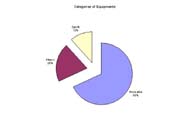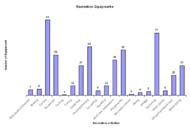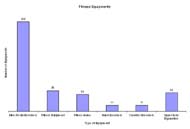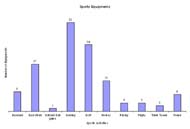Padalabalanarayan Sangeetha MS, Thirumalai Mohanraj MS, John Sam F MS and Fay Brian PhD
RERC RecTech, University of Illinois at Chicago, Illinois - 60608
ABSTRACT
There is a substantial and growing body of evidence indicating regular participation in moderate levels of exercise and recreational activities are important elements of a healthy lifestyle. RERC RecTech’s D4 project focuses on improving the health, wellness, and quality of life of people with disabilities by promoting and facilitating increased participation in physical activity and recreation by creating a centralized resource (database) for assistive technology equipment. RERC RecTech has created a PostgreSQL-driven website that provides people with disabilities with efficient access to the data relevant to assistive technology equipment through a search engine written in PHP. The web site can be accessed at http://www.rercrectech.org/.
KEYWORDS
Recreation Equipment, Fitness Equipment, Sports Equipment, Solutions Database, RERC RECTECH
BACKGROUND
The development of innovative strategies for improving health, preventing secondary conditions associated with a disabling condition, and adequately preparing individuals with disabilities to understand and manage their own health has emerged as an important public health priority (1). Central to this effort is an awareness that individuals with disabilities are likely to be at increased risk for a number of preventable health problems or secondary conditions. Secondary conditions are health concerns that are not a direct result of the primary disability but rather, are acquired at a later time due to physical and lifestyle changes resulting from the primary disability (2, 3, and 4).
Practical adaptations and strategies to allow persons with disabilities to participate in recreational and fitness activities have been in use for many years. Unfortunately, there is no central repository for information or specifications on these adaptations and technologies. Consequently, there is no easy method for matching identified recreational and exercise needs with existing technologies or products. As a result, people with disabilities often have limited, even singular usage options.
 |
|---|
While there are a large and growing number of resources regarding assistive technology, there are relatively few resources focused on the application of such technology to recreation and physical activity. Much of the available information is in print materials targeted at educators, rehabilitation engineers, rehabilitation or fitness professionals, and assistive technologists. The lack of a centralized resource for such information makes it more difficult for both professionals and end users to access available solutions. Print-based dissemination strategies are costly to create and cumbersome to use. Also, print materials rapidly become outdated in this growing and developing field.
SOLUTION CONSIDERED
 |
|---|
A fundamental task of the proposed RERC RecTech was to identify, collect, and catalog information on currently available recreational technologies and maintain this information in a searchable database readily available to professionals and the public via the Internet. This approach allowed the RERC RecTech to produce a rapid beneficial impact by using information technology to make available solutions more accessible to professionals and consumers.
 |
|---|
Reliability of the database, search tools and website is a primary concern. The technology required for the proposed solutions database development project is well established and thoroughly tested. The solutions database was created with normalized data structures (Database normalization is a series of steps followed to obtain a database design that allows for consistent storage and efficient access of data in a relational database. These steps reduce data redundancy and the risk of data becoming inconsistent) and integrated into the RERC website. The final configuration is developed consistent with choices made for the RERC website. The configuration is comprised of a Red Hat Linux operating system, an Apache Web server, a PostgreSQL database server, and PHP as the web development language.
 |
|---|
The exact structure of the solutions database was created through an interactive development process in which RERC RecTech database specialists worked with the RERC-RecTech National Consumer Advisory Panel members to determine information of greatest use and value to consumers. RERC RecTech Rehabilitation Engineering Advisory Panel members were also consulted to determine information of greatest use and value to engineers and assistive technology specialists.
The processes of identifying, classifying, collecting, and entering items for the solutions database were completed in parallel with the development of the database. Staff members began by reviewing and updating the resources listed in Nesbitt (1986) and Paciorek and Jones (2001). Sources referenced in these collections were contacted by project staff for current information and inclusion in the database. RERC staff has contacted each of the 56 projects funded under the Assistive Technology Act of 1998 (P.L.105-394) to notify them of the solutions database initiative and request participation in both publicizing the project and submitting items for inclusion in the database. Responses from them will be added to the database.
 |
|---|
The products in the database are divided into three main categories: Fitness, Recreation and Sports. These categories are further classified into a number of sub-categories based on the activities in each of the category. Each listing contains a detailed description of the product. We then classify the product as an equipment adaptation or personal adaptation. Manufacturer and distributor details for each product are also given in the database.
OUTCOME
 |
|---|
As a result of the staff’s continuous efforts to collect information, more than 1000 equipment options are now listed in the database and are updated on a day to day basis. Recreational options represent the majority of options identified to date (68%), while fitness (20%) and sports equipment (12%) are less common.
Among recreational equipments, cycling and swimming are the most common while fencing, home-recreation and skiing features fewer options.
Among fitness equipment, bike/pedal exercisers are the most common while hand and shoulder exerciser types are less common.
Among sports equipment, equipment facilitating bowling and golf are most common while bat & ball games and table tennis are the sport activities with least number of options.
It should be noted that assistive equipment for camping and bird-watching has not been identified to date.
REFERENCES
- U.S. Department of Health and Human Services. (2000). Healthy people 2010: Understanding and improving health. Retrieved January 12, 2005, from http://www.healthypeople.gov/Document/Word/uih/uih.doc
- Patrick, D. L., Richardson, M., Starks, H. E., & Rose, M. A. (1994). A framework for promoting the health of people with disabilities. Paper presented at the Preventing Secondary Conditions associated with Spina Bifida or Cerebral Palsy: Proceedings and Recommendations of a Symposium, Crystal City, Virginia.
- Ravesloot, C., Seekins, T., & Young, Q. R. (1998). Health promotion for people with chronic illness and physical disabilities: The connection between health psychology and disability prevention. Health Psychology, 5, 76-85.
- Rimmer, J. H., & Braddock, D. (2002). Health promotion for people with physical, cognitive, and sensory disabilities: An emerging national priority. American Journal of Health Promotion, 16(4): 220-224.
ACKNOWLEDGEMENT
This project was supported by Grant Number DED H133E020715 from the National Institute on Disability and Rehabilitation Research (NIDRR).
AUTHORS DETAILS
Sangeetha Padalabalanarayanan
1640 W Roosevelt Road, Suite 711
Chicago – IL 60608.
Phone: 312-355-0119
Email: spadal3@uic.edu